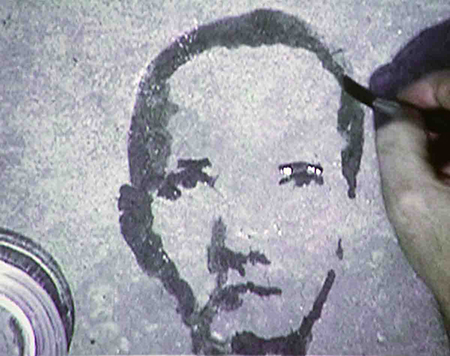
Continuing through April 13, 2014
Carefully and thoughtfully curated by Irina Costache, “Global Voices, Diverse Narratives: One Medium, Video” is a demonstration of the present range and scope of video as art. Although the videos are arranged on a loop, deliberately denying primacy to any one artist, it is possible for the viewer to mentally put together a timeline of artistic attitudes towards a medium once analogue and now digital. In “Enclosure” (1973) feminist Linda Bengelis shows herself “starring” in her own intervention into the male-dominated world of mass media. But forty years later, our perspective is now altered. We see the position of curiosity and critique, a consciousness of the novelty of television and video, now absent with the younger generation. Oscar Muñoz’s “Re/trato” (2003) delivers a message of futility, as the artist spends 28 minutes painting and repainting a watercolor portrait on hot pavement. Although both works are in black and white, the rough surface used by Muñoz takes the place of the graininess of early film and the vanishing paint becomes a critique, not of communication, but of the difficulty of any person to leave their mark over time.
Equally interesting is evidence of intertexuality in a medium that is now mature and no longer “pure.” Antonella Busssanich’s beautiful and artful moving portraits are directly connected to European photography of the 1920s, and Francis Alÿs’ work appears to be an extension of contemporaneous conceptual art. However, the exhibition provides a point of contrast: Lawrence Weiner’s “Deep Blue Sky” (2002) may be recent but presents his trademark pithy statements from the seventies. On the surface the video by Alÿs, “Sometimes Making Something Leads to Nothing” (1997), in which the artist uses his hands and feet to push an ever-diminishing block of ice through the streets of Mexico City until it becomes a tiny pool of water, seems to be a typical conceptual performance. But far from subscribing to the casual production values of that aesthetic, the video is a sophisticated production, not a performance. The camera work is straight out of the movies and is decisively different from the straightforward point-and-shoot approach of Busssanich.
The most salient point that emerges from the exhibition is how video is no longer “video” but an art form called “video” grounded in film, but which has moved well beyond the original confines and purposes. Christian Marclay’s “Telephones” (1995), a montage of found film footage of characters picking up a telephone (no cells) and saying hello and good-bye. Next to Charlie White’s brightly colored and charming animation “OMB BFF LOL” (2008), in which two valley girls discuss the heavy topics of “wanting” and “having” and the resulting condition of ennui brought on by over-indulgence, Marclay’s hello-goodbye slides into history. White reveals that “Desire at the Mall” is now the road to self-actualization and the postmodern site of existentialism.
